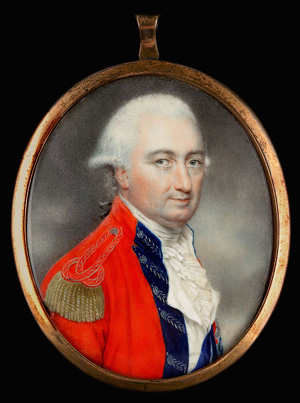Charles Cornwallis, 1st Marquess Cornwallis (1738-1805)

Charles Cornwallis was sympathetic to American views during pre-war political disputes in Parliament but became one of the most prominent British generals during the War for Independence. He is known for his surrender at Yorktown, Virginia, in October 1781 after allowing his army to become trapped there. His surrender was catastrophic for British hopes to retain the colonies and brought down the ministry of Lord North.
Born in London on December 31, 1738, to Charles, 1st Earl Cornwallis, and Elizabeth Townshend, the younger Charles was educated briefly at Eton and entered Clare College, Cambridge, but chose a military career over academics. When the Seven Years War broke out in Europe, Cornwallis served with distinction and was present at the Battle of Minden in 1759. He was elected to Parliament in 1760 but returned to the Continent as Lieutenant Colonel in command of the 12th Regiment of Foot and saw heavy action until 1762. Upon his father's death he succeeded to the title of 2nd Earl Cornwallis and took his seat in the House of Lords as an unlikely ally of the Rockingham whigs. Of particular note were his support for John Wilkes against charges of sedition and his opposition to the Stamp Act for the American colonies and to general warrants (under which Wilkes had been originally arrested). He voted to repeal the Stamp Act and voted against the Declaratory Act in 1766 (one of only five Lords to do so). Cornwallis' clear loyalty to the Crown, however, earned him appointments as lord of the bedchamber, Colonel in command of the 33rd Regiment of Foot, and, in 1770, to the Privy Council. He was made constable of the Tower of London in 1771.
In 1775 Cornwallis was promoted to Major General and volunteered for duty to suppress the rebellion in America, putting loyalty to the King and constitution above his support for colonial rights. In February 1776 he sailed from Ireland with 12 regiments, totaling 2500 men. He commanded the reserve in the victory over Washington at the Battle of Long Island on August 27, helped force the surrender of Fort Washington (and more than 2800 American soldiers) on November 16, and almost trapped another sizable Continental force at Fort Lee several days later. The subsequent New Jersey campaign did not proceed so well for Cornwallis, who cornered Washington's exhausted forces near Princeton but allowed them to escape to safety under the cover of darkness on January 3, 1777. This infuriated Sir Henry Clinton, his commander, who later described Cornwallis' failure as "the most consummate ignorance I ever heard of [in] any officer above a corporal." Cornwallis fared better in the Philadelphia campaign in the fall of 1777. At the Battle of Brandywine on September 11 he led the central effort that drove Washington from the field, and at the Battle of Germantown on October 4 he brought timely reinforcements that secured the field for the British. Cornwallis then went to England on leave, during which he was promoted to Lieutenant General.
When Cornwallis returned to America in April 1778 it was as second-in-command to Clinton, who had not forgiven him for failing to pursue Washington at Princeton. At the Battle of Monmouth on June 28 his portion of Clinton's army was attacked by Charles Lee. Near the close of the battle, Cornwallis personally led a major assault on the American right but was driven back. News that his wife, Jemima Tulikens Cornwallis, was dying then took him back to England; she died on February 16, 1779, and he remained there for almost an entire year.
Cornwallis was back in America by May 1780, for Clinton's southern campaign through the Carolinas. He assisted Clinton in the capture of Charleston on May 12, 1780, and then took command of the entire operation when Clinton returned to New York. Moving through the Carolinas to connect with loyalists and restore royal government, Cornwallis virtually destroyed Horatio Gates' army at the Battle of Camden on August 16. He then made a fateful decision with approval from London but without consulting Clinton. He moved to strike a decisive blow by going into Virginia, believing that a major victory there "may give us America." Defeats of parts of his forces at the Battle of Kings Mountain on October 7 and at Cowpens on January 17, 1781, did not deter him from proceeding northwards. The Virginia campaign that ended with Cornwallis' surrender at Yorktown on October 19, 1781, effectively ended the American War for Independence. It is important to note that Cornwallis never received the blame for his missteps in Virginia from either his contemporaries or from the vast majority of historians since (the fault has been laid primarily at Clinton's door).
Cornwallis was exchanged for Henry Laurens in May 1782. Several years later, in 1786, he accepted the position of the first Governor-General of India, was elevated to 1st Marquess Cornwallis in 1793, and then in 1797 appointed Lord Lieutenant of Ireland. He effectively suppressed an Irish rebellion that had French support. He was asked to return to India in 1805 and died on October 5, several months after his arrival there. Cornwallis was buried near the banks of the River Ganges, near Ghazipur.












